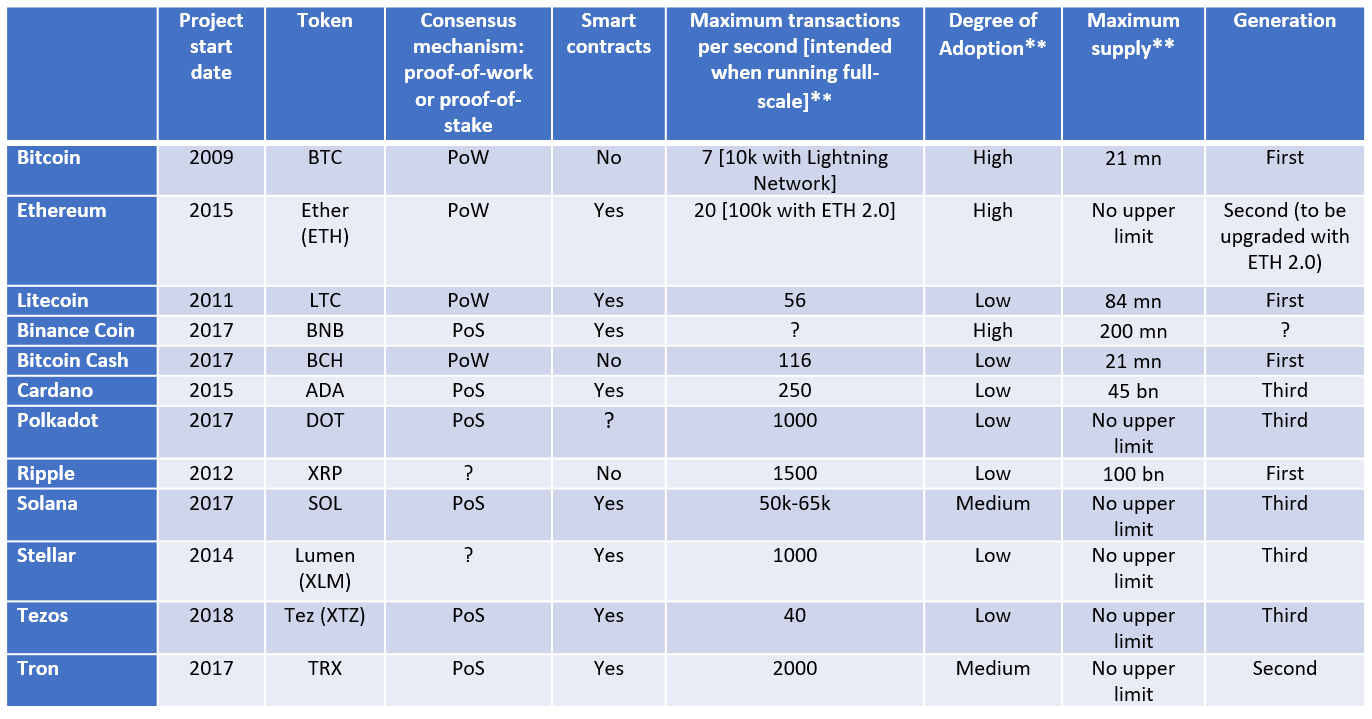Metrics for comparing cryptocurrencies
Cryptocurrencies may be compared on a number of metrics. We think the key properties to consider are:
- Adoption: We see an investment into cryptocurrencies as investments into a network, and the value of a network is determined by the number of users and network operators, the network activity, and the use case for the underlying technology in different applications. Early movers like Bitcoin and Ethereum have the upper hand compared to some of the newer cryptos, and Ethereum also benefits from the large number of applications running on its blockchain through its smart contracts.
- Smart contracts: Smart contracts can be seen as small computer programs running on the blockchain, allowing additional features than on a basic blockchain. Only some cryptocurrencies offer this functionality, as especially older ones like Bitcoin is lacking the feature. Smart contracts are working as strings of preprogrammed conditional events, e.g. transfer X money to Y, but only after the recipient has confirmed identity. Smart contracts enable not only payments but transfers of everything which can be put on a digital form – e.g. digital art, digital securities, loans etc. They are also the core behind DeFi, decentralized finance, and ICOs (initial coin offerings).
- Consensus algorithm: To operate a decentralized network without the traditional middleman to verify all transactions on the network, the network must have a consensus algorithm which states how transactions are verified on the network. The most well-known is the proof-of-work (PoW) used e.g. by Bitcoin, where miners run the network through solving cryptographic algorithms on power-consuming computers and data centers. Another big consensus algorithm is the proof-of-stake (PoS), where it is not agents with a large computational power who are running the network, but instead holders (stakers) of the underlying cryptocurrency who run the network. The proof-of-work algorithm has the longest track record and some see it as being the most secure algorithm, whereas proof-of-stake has much lower energy requirements for running and securing the blockchain, making proof-of-stake more scalable of the two.
- Speed and scalability: For a crypto to be adopted as a medium for carrying out transactions on a global and daily basis, it demands both fast transaction speed and the ability to process many transactions per second. These numbers are provided in the table below for the different cryptos, and compared to Visa’s possibility of processing around 1,700 transactions per second (with possibility of increasing this number), especially the older cryptos have difficulties in matching this number. A lot of the older cryptocurrencies are, however, working on solutions for boosting scalability.
- Store-of-value and inflation: Despite the high volatility in the crypto space, many investors are looking to cryptos as a store-of-value, such as for Bitcoin being called the “digital gold”. Whereas some crypto currencies such as Bitcoin, Cardano and Litecoin has a finite supply, other cryptos such as Ethereum and Stellar have no upper limit for the issued number of crypto tokens and are thus inflationary by nature. Newly issued crypto coins are typically issued as a reward to those who are validating the networking, causing the inflation. Some cryptos are though seek to limit the inflation by burning (destroying) a part of the transaction fees, keeping inflation at a minimum to run the network.
- Governance and developer team: Some cryptos have a designated developer team for maintaining and upgrading the blockchain, such as Ethereum, whereas other network such as Bitcoin are more decentralized. The benefit of having a centralized team running the network is that upgrades and fixes of security breaches may quickly be rolled out such as the Ethereum 2.0 upgrade mentioned below, but the dependency of a small group is also against the decentralized nature of the original thoughts behind cryptocurrencies. For comparison, Bitcoin has around 12 improvement proposals per year since inceptions, whereas Ethereum is close to 60 per year since inception.
- Technological advancements: The first generation of cryptocurrencies origins with Bitcoin and the associated technologies, originally created as a decentralized currency made to store and transfer value. Second generation expands on the first by including smart contracts, but is still limited technology wise. Third generation cryptos are building on top of the those of the second generation when it comes to scalability, sustainability and interoperability between blockchains. It should be noted that not all cryptos map directly into this division of generations – e.g. Ethereum was created as a second gen crypto, but with the Ethereum 2.0 upgrade, it will have properties similar to third gen cryptos.
Looking at the individual cryptos
Below we compare various cryptocurrencies on metrics based on those above, and we provide details on how we see each individual cryptocurrency.

Bitcoin – the innovator
Bitcoin benefits from being an early player in the crypto space and is well-known by many, but it also has some technical limitations. It uses the energy-heavy mining framework for verifying transactions and has limited potential when used for transactions, due to the limited transaction bandwidth. Bitcoin is often acknowledged as a store of value rather than a transaction media due to its scarcity, despite the large volatility.
Ethereum – the multi-purpose blockchain
Ethereum is the second-biggest cryptocurrency measured on market capitalization, and the applications of the Ethereum technology goes way beyond financial transactions through smart contracts. The long history of Ethereum has built up its large infrastructure through decentralized applications, contributing to the expanding ecosystem. This includes decentralized finance, initial coin offerings, non-fungible tokens and blockchain games. The current limitations in transaction speed and the large power consumption are being considered in a large ongoing upgrade to the whole blockchain, Ethereum 2.0, which seeks to implement proof-of-stake instead of proof-of-work.
Litecoin – a duplicate
Litecoin was created as a duplicate of Bitcoin. Thereby, the cryptocurrencies shares many similarities like finite supply and close to identical consensus mechanism to verify transactions. A few changes have, however, made Litecoin able to process slightly more transactions and opened its network for smaller miners, but it has never been acknowledged to the same extent as Bitcoin.
Binance Coin – the scalable, centralized exchange-blockchain
Binance Coin was originally introduced by the cryptocurrency exchange Binance for enabling peer-discounted trading, but the use cases have expanded to several different applications, with the primary being to pay trading fees on the Binance exchange. On a quartlerly basis, Binance permanently destroys (burns) coins corresponding to 1/5 of the exchange’s profits, which is seen as a payback to the holders of the coin. The most important use case is Binance Chain, with many of the same functionalities as Ethereum, though by being significantly more centralized.
Bitcoin Cash – the Bitcoin rebel
Bitcoin Cash originated as a hard-fork (spin-off) of Bitcoin, seeking to improve the block size, improving scalability and allowing more transactions to be processed, although in a different way of the rest of the Bitcoin network, which went with the SegWit upgrade. It was initiated by developers and bitcoin miners who were questioning the future scalability of Bitcoin.
Cardano – an ”updated” Ethereum equivalent
Cardano is an open-source blockchain seeing itself as an updated version of Ethereum when it comes to technical advantages such as transaction speed and functionality. Cardano implements a two-layer blockchain system, which allows the creation of more advanced smart contracts, opening of for additional possibilities of requiring the revealing/hiding the identity of the receiver/sender, which may be useful in specific applications. The implementation of smart contracts are formally verified on the network, making it less prone to bugs, which are a significant issue when using smart contracts.
Polkadot – Blockchain across blockchains
Polkadot was developed by a co-founder of Ethereum, and the intention is to create a platform connecting public, private and other kinds of networks into one big ecosystem. Individual blockchains can operate as the usually do, but the Polkadot technology allows cross-transactions between the blockchains. Developers can create their own sub-blockchains to the main network, the so-called parachains, which each may have different applications, but being connected through the mother blockchain. Polkadot provides transaction scalability through processing transactions in separate shards of the blockchain.
Ripple – the global, rapid payments network
The Ripple technology is both a system for digital transactions and a cryptocurrency, and the main purpose is to provide a system for settlement of payments and remittance equivalent to the SWIFT system for international transfers of money and securities, but without any middlemen. It is a global payments network and potential customers are larger financial institutions and banks. Ripple verifies transactions through bank-owned servers, and the XPR currency is used as a bridge between different currencies and allows easy exchange from one to another. It improves some of the drawbacks with traditional banks by carrying out transactions in a couple of seconds and for low fees – in contrast to a couple of days for an expensive wire transfer.
Tezos – governance on-chain
The key feature of Tezos is a self-governing system, which does not require any controversies and spin-offs upon implementation of upgrades, as all governance and voting on changes are done on-chain. This means that developers can submit upgrade proposals directly on the network and thus stakeholders get a larger influence on which direction the crypto should evolve. The intention is thus to have a system which is evolving with as much flexibility as possible. This is different from e.g. Ethereum, where upgrades and changes to a large degree are dictated by the Ethereum foundation and developers.
Solana – censorship-resistant crypto with time clock
Solana applies a cryptographic clock, which in essence gives every transaction a timestamp, which reduces the transaction latency ass less time will be needed to verify the order of transactions. At the same time, it disables the possibility for bots and miners to decide on the order of how transactions should be recorded on the blockchain, giving larger resistance to censorship. Transactions are also forwarded to the validators before processing of the previous batch of transactions has been completed, which boost the transaction bandwidth and confirmation speed, as processes and handled in parallel.
Stellar – the decentralized alternative to Ripple
Stellar is a multicurrency payment platform created to enable creation of digital representations of all forms of money, both fiat and cryptocurrency, as well as sending and trading these. The agenda is quite similar to Ripple, but the target users are different. Whereas Ripple seeks partnerships with banks, Stellar is focusing on unbanked individuals.
Tron – a global entertainment system
Tron was created as a decentralized competitor to existing companies within digital entertainment, in order to provide digital content in a cheaper way that the existing providers by allowing content providers to sell content directly to the consumer, without the need of any middleman like Netflix or Amazon.




